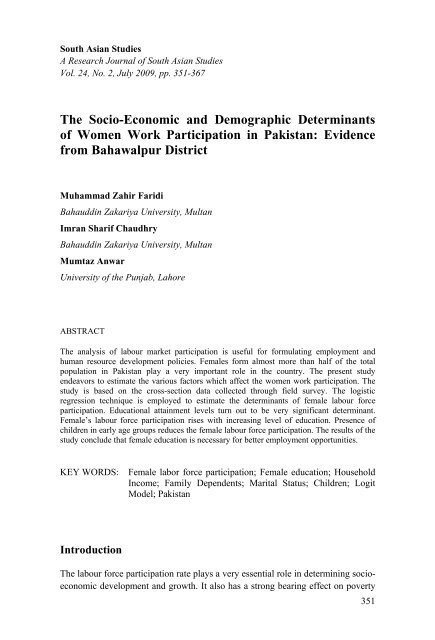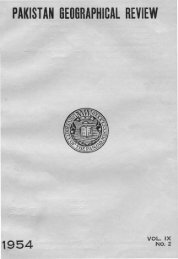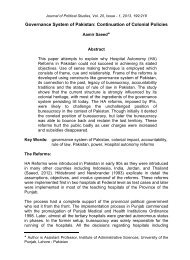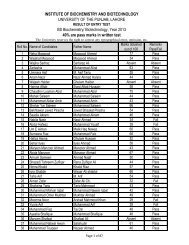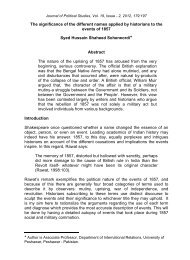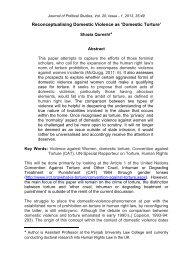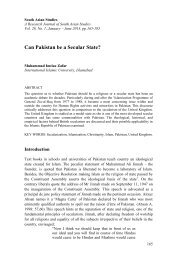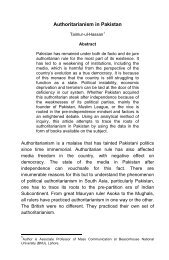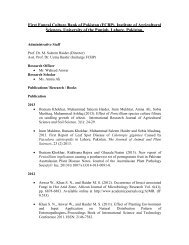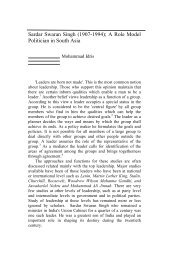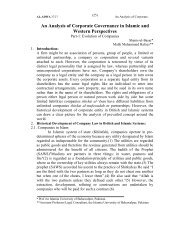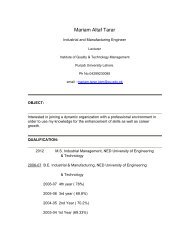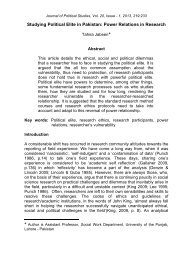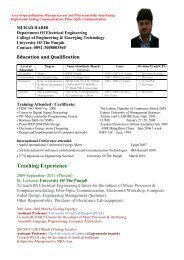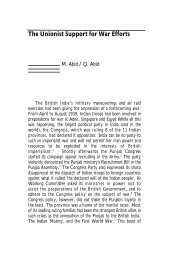The Socio-Economic and Demographic Determinants of Women ...
The Socio-Economic and Demographic Determinants of Women ...
The Socio-Economic and Demographic Determinants of Women ...
Create successful ePaper yourself
Turn your PDF publications into a flip-book with our unique Google optimized e-Paper software.
South Asian Studies<br />
A Research Journal <strong>of</strong> South Asian Studies<br />
Vol. 24, No. 2, July 2009, pp. 351-367<br />
<strong>The</strong> <strong>Socio</strong>-<strong>Economic</strong> <strong>and</strong> <strong>Demographic</strong> <strong>Determinants</strong><br />
<strong>of</strong> <strong>Women</strong> Work Participation in Pakistan: Evidence<br />
from Bahawalpur District<br />
Muhammad Zahir Faridi<br />
Bahauddin Zakariya University, Multan<br />
Imran Sharif Chaudhry<br />
Bahauddin Zakariya University, Multan<br />
Mumtaz Anwar<br />
University <strong>of</strong> the Punjab, Lahore<br />
ABSTRACT<br />
<strong>The</strong> analysis <strong>of</strong> labour market participation is useful for formulating employment <strong>and</strong><br />
human resource development policies. Females form almost more than half <strong>of</strong> the total<br />
population in Pakistan play a very important role in the country. <strong>The</strong> present study<br />
endeavors to estimate the various factors which affect the women work participation. <strong>The</strong><br />
study is based on the cross-section data collected through field survey. <strong>The</strong> logistic<br />
regression technique is employed to estimate the determinants <strong>of</strong> female labour force<br />
participation. Educational attainment levels turn out to be very significant determinant.<br />
Female’s labour force participation rises with increasing level <strong>of</strong> education. Presence <strong>of</strong><br />
children in early age groups reduces the female labour force participation. <strong>The</strong> results <strong>of</strong> the<br />
study conclude that female education is necessary for better employment opportunities.<br />
KEY WORDS: Female labor force participation; Female education; Household<br />
Income; Family Dependents; Marital Status; Children; Logit<br />
Model; Pakistan<br />
Introduction<br />
<strong>The</strong> labour force participation rate plays a very essential role in determining socioeconomic<br />
development <strong>and</strong> growth. It also has a strong bearing effect on poverty<br />
351
M. Zahir Faridi, Imran Sharif Ch. & Mumtaz Anwar <strong>The</strong> <strong>Socio</strong>-<strong>Economic</strong><br />
reduction. <strong>The</strong> labour force participation rate shows the supply <strong>of</strong> labour in the<br />
economy <strong>and</strong> the composition <strong>of</strong> the human resources <strong>of</strong> the country. <strong>The</strong> analysis<br />
<strong>of</strong> the labour force participation is helpful in determining employment policy <strong>and</strong><br />
policy formulation for human resource development. Females constitute about half<br />
<strong>of</strong> the total population in Pakistan <strong>and</strong> play a very significant role in the economy.<br />
<strong>The</strong> trend <strong>and</strong> structure <strong>of</strong> the female labour force participation (FLFP) has<br />
attracted attention over the past few decades in the world <strong>and</strong> from the past few<br />
years in the Pakistan. <strong>The</strong> incidence <strong>of</strong> women work participation is low in<br />
Pakistan. Although the average annual growth rate <strong>of</strong> women work participation is<br />
rising slightly in Pakistan, which was 15.9 percent during the period 2003-04 <strong>and</strong><br />
has gone up to 18.9% during the period 2005-06 1 . But still women work<br />
participation is very low as compared to the south Asian countries.<br />
This study is an effort to identify the socio-economic <strong>and</strong> demographic factors<br />
which determine the women work participation. This issue has been analyzed in<br />
many studies 2 but these studies have been generally failed to incorporate various<br />
socio-economic <strong>and</strong> demographic variables in their analysis. In the present study,<br />
we have attempted to analyze the relationship <strong>of</strong> age pr<strong>of</strong>ile <strong>of</strong> the women <strong>and</strong> all<br />
levels <strong>of</strong> education with work participation <strong>of</strong> the females in some detail.<br />
<strong>The</strong> study is planned into five sections. Introduction is presented in the first<br />
section. <strong>The</strong> second section provides the review <strong>of</strong> literature. In the third section,<br />
we have discussed methodology, data sources <strong>and</strong> variables. <strong>The</strong> results <strong>of</strong> the<br />
estimation are presented in the fourth section. We have <strong>of</strong>fered some concluding<br />
remarks <strong>and</strong> policy implications in the last section.<br />
Literature Review<br />
Literature review on labor force participation <strong>and</strong> supply <strong>of</strong> labor both at national<br />
<strong>and</strong> international level is discussed in this section. A number <strong>of</strong> studies can be<br />
observed in the literature relating to the economic theory <strong>of</strong> the household. Becker<br />
(1965) <strong>and</strong> Gronau (1977) is the beginner <strong>of</strong> the field <strong>and</strong> explained the household<br />
behavior regarding time allocation. However, a vast variety <strong>of</strong> literature based on<br />
empirical studies especially for developed nations is available. Most <strong>of</strong> them are<br />
survey based <strong>and</strong> these surveys are carried by Macurdy, Heckman (1980) <strong>and</strong><br />
Heckman <strong>and</strong> Killingworth (1986).<br />
Mincer (1962) has discussed the relationship between working hours <strong>and</strong><br />
female labor force participation overtime. He has explored that wife’s dem<strong>and</strong> for<br />
leisure is not influenced by income <strong>of</strong> the family. <strong>The</strong> probability <strong>of</strong> labor force<br />
participation <strong>and</strong> lifetime wealth measures are inversely related. <strong>The</strong> study<br />
concludes that number <strong>of</strong> children significantly influences the female labor force<br />
participation decision.<br />
Shah et al. (1976) has studied the effects <strong>of</strong> some selected demographic <strong>and</strong><br />
socio-economic variables on labor force participation in all the provinces <strong>of</strong><br />
352
South Asian Studies 24 (2)<br />
Pakistan. <strong>The</strong> results show that the labor force participation is negatively related<br />
with nuclear family type <strong>and</strong> child-women ratio. <strong>The</strong> study indicates that there is<br />
direct relationship between labor force participation <strong>and</strong> marital status. He also has<br />
found that dependency ratio <strong>and</strong> literacy ratio have positive influence on labor<br />
force participation.<br />
Kozel <strong>and</strong> Alderman (1990) have analyzed the factors affecting work<br />
participation <strong>and</strong> labor supply decision in the urban areas <strong>of</strong> Pakistan. He has used<br />
OLS regression <strong>and</strong> Tobit model to estimate the correlates. <strong>The</strong> study concludes<br />
that the women work participation rises with an increase in the expected earning,<br />
wages <strong>and</strong> level <strong>of</strong> education.<br />
Malik et al. (1994) has investigated the factors, which influence female labor<br />
force participation in economic activities. He has explored that women’s age,<br />
education <strong>and</strong> the number <strong>of</strong> dependents do not significantly determine market<br />
time. <strong>Women</strong> labor supply is significantly <strong>and</strong> positively affected by women wage<br />
rate <strong>and</strong> predicted male wage rate.<br />
Aly <strong>and</strong> Quisi (1996) has discussed socio-economic factors that affect<br />
Kuwaiti women’s labor market participation decision. <strong>The</strong> study concludes that<br />
females’ wage rate <strong>and</strong> education are positively related with labor force<br />
participation rate. It has been also found that marital status, the number <strong>of</strong> children<br />
<strong>and</strong> age is inversely related with labor force participation rate.<br />
Azid et al. (2001) have studied the factors influencing female participation in<br />
cottage industry <strong>of</strong> Pakistan. <strong>The</strong> main objective <strong>of</strong> the study is to analyze the<br />
economic behavior <strong>of</strong> the female workers involved in the business <strong>of</strong> embroidery.<br />
<strong>The</strong> study has concluded that number <strong>of</strong> the children, age <strong>of</strong> the females,<br />
education, poverty status have a positive <strong>and</strong> significant impact on female labor<br />
force participation.<br />
Naqvi <strong>and</strong> Shahnaz (2002) have examined the effects <strong>of</strong> various demographic,<br />
socio-economic <strong>and</strong> human capital related factors on women participation in<br />
economic activities. <strong>The</strong>y have used cross-sectional data from integrated<br />
household survey (PIHS) (1998-99) for the age group <strong>of</strong> 15-49 years. <strong>The</strong> probit<br />
<strong>and</strong> multinomial logit model has been used to estimate the parameters. <strong>The</strong> probit<br />
estimates indicate that marital status, primary education, number <strong>of</strong> children <strong>and</strong><br />
female head <strong>of</strong> households are inversely related with women’s participation in<br />
economic activities.<br />
Khan et al. (2005) have focused on hazardous nature <strong>of</strong> home-based work <strong>of</strong><br />
women <strong>and</strong> children. <strong>The</strong>y have investigated the contribution <strong>of</strong> women <strong>and</strong><br />
children to the total family income <strong>and</strong> the impact <strong>of</strong> increased income on raising<br />
household nutrition, health <strong>and</strong> education. <strong>The</strong> study has concluded that household<br />
size is significantly <strong>and</strong> positively influencing the decision <strong>of</strong> household to engage<br />
in home-based work while living condition index inversely.<br />
Chaudhry <strong>and</strong> Nosheen (2009) analyzed the determinants <strong>of</strong> women<br />
empowerment in Southern Punjab <strong>of</strong> Pakistan. Considering multidimensional<br />
nature <strong>of</strong> women empowerment, authors estimated the cumulative index for<br />
353
M. Zahir Faridi, Imran Sharif Ch. & Mumtaz Anwar <strong>The</strong> <strong>Socio</strong>-<strong>Economic</strong><br />
women using four indices i.e. personal autonomy, family decision making,<br />
domestic economic decisions <strong>and</strong> political autonomy. <strong>The</strong> results demonstrated<br />
that women empowerment is considerably influenced by education, access to<br />
media, socio-cultural norms <strong>of</strong> the community, job <strong>of</strong> women <strong>and</strong> household<br />
participation rate. <strong>The</strong> major emphasis <strong>of</strong> this study was on the women<br />
empowerment in terms <strong>of</strong> their participation in household economic activities.<br />
Methodology, Data Sources <strong>and</strong> Selection <strong>of</strong> Variables<br />
<strong>The</strong> data for this study is collected through filed survey in the year (2007-2008),<br />
concentrating on the sample <strong>of</strong> female labor force ages 15-64 years. Female labor<br />
force economic activities are examined by studying the various household factors<br />
different socio-economic, demographic <strong>and</strong> human capital components are also<br />
considered. A sample <strong>of</strong> 164 female workers in the age cohorts <strong>of</strong> 15-64 years is<br />
r<strong>and</strong>omly drawn from urban as well as rural areas <strong>of</strong> Bahawalpure district. <strong>The</strong><br />
Bahawalpure is one <strong>of</strong> the southern parts <strong>of</strong> the province <strong>of</strong> Punjab <strong>and</strong> situated<br />
almost in the center <strong>of</strong> the country. It consists <strong>of</strong> five tehsils namely Bahawalpure,<br />
Ahmad Pure East, Yazman, Hasilpure <strong>and</strong> Khan pure Tamewali.<br />
<strong>The</strong> analysis <strong>of</strong> the study is carried out at two levels. First a statistical analysis<br />
<strong>of</strong> female labor force participation is carried out. Secondly, the labor force<br />
decision to participate in economic activities is modeled in the framework <strong>of</strong> the<br />
traditional theory <strong>of</strong> utility maximization (see Becker, 1965) by using the<br />
maximum likelihood logit estimation technique.<br />
Logit Model<br />
<strong>The</strong> inadequacy <strong>of</strong> linear probability model suggests that non-linear specification<br />
may be more appropriate. In order to explain the dichotomous dependent variable,<br />
we will use Logit model. <strong>The</strong> Logit model assumes the following cumulative<br />
probability density function:<br />
354<br />
1<br />
1+<br />
e<br />
P ( −βX<br />
)<br />
= ----------------------- (1)<br />
i<br />
Where ‘P’ is the probability that a person participates in the labor market, “e”<br />
is the exponential value. β is the row vector <strong>of</strong> the parameters <strong>and</strong> “Xi” is the<br />
column vector <strong>of</strong> the variables.<br />
Since ‘P’ the probability <strong>of</strong> the participation in the labor market, not directly<br />
observable, a dichotomous (0,1) variable is constructed, taking the value <strong>of</strong> ‘1’ for<br />
person who participates in the labor market <strong>and</strong> zero otherwise. It is straight<br />
forward to derive the following regression equation from the logistic probability<br />
equation (1):
⎡ P ⎤<br />
Ln<br />
⎢<br />
= −βX<br />
⎣1−<br />
P ⎥<br />
⎦<br />
i<br />
South Asian Studies 24 (2)<br />
----------------------- (2)<br />
If we compare the Logit model with linear probability model, the basic<br />
advantage <strong>of</strong> Logit model is that the probability <strong>of</strong> occurrence increases with ‘x’<br />
but never steps outside the 0-1 interval <strong>and</strong> the relationship between the variables<br />
is non linear.<br />
Operational Model<br />
<strong>The</strong> general model specified above can be used as a guiding paradigm. Based on<br />
the theoretical rational, the operational model consists on the variables which are<br />
supplied by the data. Various socio-economic variables are analyzed below. <strong>The</strong><br />
justification for incorporating these variables in female labor force participation<br />
decision model <strong>and</strong> their expected signs, are discussed below.<br />
Education<br />
Education is very important factor in increasing the female labor force<br />
participation. To capture the effect <strong>of</strong> different educational levels on female labor<br />
force participation, we have included five categorical education dummy variables<br />
in our model. <strong>The</strong> expected relationship between education <strong>and</strong> FLFP is positive.<br />
Age<br />
<strong>The</strong> age <strong>of</strong> female is very crucial factor for labor force participation decision. Five<br />
categorical age dummy variables have been included in the model to trace out the<br />
effect <strong>of</strong> different age groups on FLFP. It is, therefore expected that the<br />
relationship between age <strong>and</strong> FLFP decision will be both positive <strong>and</strong> negative<br />
with respect to different age groups.<br />
Closed Relatives’ Educational Status<br />
Female labor force participation decision is also affected by the educational status<br />
<strong>of</strong> closed relative i.e. educated father, educated mother, <strong>and</strong> educated husb<strong>and</strong>. It is<br />
expected that closed relatives’ educational status <strong>and</strong> FLFP decision are positively<br />
related.<br />
355
M. Zahir Faridi, Imran Sharif Ch. & Mumtaz Anwar <strong>The</strong> <strong>Socio</strong>-<strong>Economic</strong><br />
Marital Status<br />
This variable is categorized as married <strong>and</strong> unmarried. Married women have more<br />
likely to participate in the labor market. So, both positive <strong>and</strong> negative signs are<br />
expected among marital status <strong>and</strong> FLFP.<br />
Family Setup<br />
Family set-up is another factor which affects female labor force participation<br />
decision. Females belonging to joint family system are more likely to participate in<br />
the labor market.<br />
Household Assets<br />
In our study we have considered all types <strong>of</strong> assets such financial as assets, gold,<br />
l<strong>and</strong>holding, livestock, shops etc. It is therefore, expected that assets <strong>and</strong> FLFP are<br />
inversely related.<br />
Household Size<br />
Female labour force participation is also influenced by household size. <strong>The</strong> larger<br />
the household size, the more female labour force participation. So, positive sign is<br />
expected between Household Size <strong>and</strong> FLFP.<br />
Spouse’ Participation in <strong>Economic</strong> Activities<br />
Females’ participation is inversely related with husb<strong>and</strong>s’ participation in<br />
economic activities. <strong>Women</strong> are less likely to participate in economic activities<br />
whose life partners are working.<br />
Number <strong>of</strong> Dependents<br />
<strong>The</strong> female labor force participation <strong>and</strong> number <strong>of</strong> dependents are inversely<br />
related. <strong>The</strong> expected sign between FLFP <strong>and</strong> number <strong>of</strong> dependents is negative.<br />
Location<br />
<strong>The</strong> region <strong>of</strong> residence or location plays an important role in determining female<br />
labor force participation in economic activities. This variable is classified as rural<br />
356
South Asian Studies 24 (2)<br />
<strong>and</strong> urban areas. <strong>Women</strong> belonging to rural area have more probability to<br />
participate in economic activities So, both positive <strong>and</strong> negative signs are expected<br />
among location <strong>and</strong> FLFP.<br />
Number <strong>of</strong> Children<br />
<strong>The</strong> number <strong>of</strong> children <strong>and</strong> women’s participation in economic activities are<br />
negatively related. Larger the number <strong>of</strong> children, females are less likely to<br />
participate in the labor market.<br />
Age <strong>of</strong> Children<br />
Children <strong>of</strong> various age groups, affect the female labor force participation in<br />
different manner. It is expected that children in lower age groups reduce the<br />
women’s participation while women are more likely to participate in economic<br />
activities work whose children are in the upper age groups.<br />
Husb<strong>and</strong> Salaried<br />
<strong>The</strong> expected relationship between women participation <strong>and</strong> husb<strong>and</strong> salaried is<br />
negative.<br />
Based on the description <strong>of</strong> the variables, the operational model for the<br />
estimation can be formulated as below.<br />
⎛ EDUCI , EDUCII , EDUCIII , EDUCIV , EDUCV , AGE1,<br />
AGE 2,<br />
AGE 4,<br />
AGE 5,<br />
⎞<br />
⎜<br />
⎟<br />
FLFP = f ⎜ EDUCM , EDUCF , EDUCS , MARTS , PHAST , SPART , FAMUP , NDEPT , ⎟<br />
⎜<br />
⎟<br />
⎝ HSIZE , LOCATION , NOCHD , CHLDA , CHLDB , CHLDC , HUBSC<br />
⎠<br />
Description <strong>of</strong> Variables<br />
Dependent Variable<br />
FLFP = 1 if the female participate in economic activities <strong>and</strong> ‘0’ otherwise.<br />
Explanatory Variables<br />
Educational Attainment<br />
EDUC I = 1 if the female level <strong>of</strong> education is up to middle <strong>and</strong> ‘0’<br />
otherwise.<br />
EDUC II = 1 if the female level <strong>of</strong> education is matric <strong>and</strong> ‘0’ otherwise.<br />
357
M. Zahir Faridi, Imran Sharif Ch. & Mumtaz Anwar <strong>The</strong> <strong>Socio</strong>-<strong>Economic</strong><br />
EDUC III = 1 if the female level <strong>of</strong> education is intermediate <strong>and</strong> ‘0’<br />
otherwise.<br />
EDUC IV = 1 if the female level <strong>of</strong> education is BA/B.Sc., B.Com. BCS <strong>and</strong><br />
‘0’ otherwise.<br />
EDUC V = 1 if the female level <strong>of</strong> education is MA/MSc, M.Phil, Ph.D. <strong>and</strong><br />
‘0’ otherwise.<br />
Age Groups<br />
AGE 1 = 1 if the female belongs to age group (15-24) years <strong>and</strong> ‘0’ otherwise.<br />
AGE 2 = 1 if the female belongs to age group (25-34) years <strong>and</strong> ‘0’ otherwise.<br />
AGE 3 = 1 if the female belongs to age group (35-44) years <strong>and</strong> ‘0’ otherwise.<br />
AGE 4 = 1 if the female belongs to age group (45-54) years <strong>and</strong> ‘0’ otherwise.<br />
AGE 5 = 1 if the female belongs to age group (55-64) years <strong>and</strong> ‘0’ otherwise.<br />
Presence <strong>of</strong> Closed Relatives’ Education<br />
EDUC M = 1 if female’s mother is educated <strong>and</strong> ‘0’ otherwise.<br />
EDUC F = 1 if female’s father is educated <strong>and</strong> ‘0’ otherwise.<br />
EDUS = 1 if spouse is educated <strong>and</strong> ‘0’ otherwise.<br />
MARTS = 1 if female is married <strong>and</strong> “0” otherwise.<br />
PHAST = 1 if female has assets <strong>and</strong> “0” otherwise.<br />
SPART = 1 if the female’s husb<strong>and</strong> is working <strong>and</strong> “0” otherwise.<br />
FAMUP = 1 if female belongs joint family <strong>and</strong> “0” otherwise.<br />
NDEPT = Total number <strong>of</strong> dependents in the family.<br />
HSIZE = Household Size in numbers.<br />
LOCTN = 1 if female lives in Urban area <strong>and</strong> “0” otherwise.<br />
NOCHD = Number <strong>of</strong> Children in the Family.<br />
HUBSL = 1 if husb<strong>and</strong> is salaried <strong>and</strong> “0” otherwise.<br />
CHLDA = 1 if the children belongs to the age group (0-2) <strong>and</strong> “0” otherwise.<br />
CHLDB = 1 if the children belongs to the age group (3-6) <strong>and</strong> “0” otherwise.<br />
CHLDC = 1 if the children belongs to the age group (7-11) <strong>and</strong> “0” otherwise.<br />
Results <strong>and</strong> Discussion<br />
Descriptive Analysis<br />
<strong>The</strong> elementary analysis <strong>of</strong> our study is concerned with establishing descriptive<br />
statistics <strong>of</strong> some selected variables. <strong>The</strong> elementary analysis aims to give an<br />
overview <strong>of</strong> the variables <strong>and</strong> provide the behavioral patterns <strong>of</strong> variables. Table 1<br />
presents the results <strong>of</strong> the summary statistics <strong>of</strong> the descriptive analysis. <strong>The</strong> table<br />
1 shows that on the average 0.2744 female workers have basic education up to<br />
middle level <strong>and</strong> highly educated female on the average are 0.1524. But highly<br />
358
South Asian Studies 24 (2)<br />
educated females have less variability as compared to female workers having basic<br />
education.<br />
Variables Mean St<strong>and</strong>ard Deviation<br />
EDUCI 0.2744 0.4476<br />
EDUCII 0.2195 0.4152<br />
EDUCIII 0.1707 0.3774<br />
EDUCIV 0.1524 0.3605<br />
EDUCV 0.1524 0.3605<br />
AGE1 0.1768 0.3827<br />
AGE2 0.2134 0.4110<br />
AGE3 0.2683 0.4444<br />
AGE4 0.2378 0.4270<br />
AGE5 0.1037 0.3058<br />
EDUCM 0.3659 0.4831<br />
EDUCF 0.6159 0.4879<br />
EDUCS 0.5732 0.4961<br />
MARTS 0.7805 0.4152<br />
PHAST 0.5427 0.4997<br />
SPART 0.5488 0.4991<br />
FAMUP 0.6037 0.4906<br />
NDEPT 4.701 1.954<br />
HSIZE 7.140 2.60<br />
LOCTN 0.3537 0.4796<br />
NOCHD 3.177 2.139<br />
HUBSL 0.5122 0.5014<br />
CHLDA 0.1588 0.3664<br />
CHLDB 0.3659 0.4831<br />
CHLDC 0.5244 0.5009<br />
Table 1<br />
Descriptive Statistics <strong>of</strong> the Selected Variables<br />
359
M. Zahir Faridi, Imran Sharif Ch. & Mumtaz Anwar <strong>The</strong> <strong>Socio</strong>-<strong>Economic</strong><br />
Estimates <strong>of</strong> the Binomial Logit Model<br />
Table 2 explains the binomial Logit estimates <strong>of</strong> the female labour force<br />
participation into active <strong>and</strong> inactive state. We estimate the Logit model with a set<br />
<strong>of</strong> explanatory variables considering female labour force participation in economic<br />
activities. Table depicts three sets <strong>of</strong> numbers such as estimated coefficients, their<br />
asymptotic Z-statistics <strong>and</strong> marginal effects in column 2, 3 <strong>and</strong> 4 respectively.<br />
Marginal effects show the probability derivatives at the sample mean. <strong>The</strong><br />
probability derivative indicates the change in probability due to one unit change in<br />
a given explanatory variable after holding all other variables as constant. We<br />
estimate these derivatives at the mean <strong>of</strong> sample because binomial Logit model is<br />
non-linear <strong>and</strong> its probability derivatives are not constant.<br />
This study has used two-tailed test <strong>of</strong> significance or Z-statistic for<br />
determining the acceptance or rejection <strong>of</strong> null hypothesis to check the reliability<br />
<strong>of</strong> the point estimates. For this purpose, 1 percent, 5 percent, <strong>and</strong> 10 percent level<br />
<strong>of</strong> significance has been used. <strong>The</strong> intercept term in binomial Logit equation is<br />
positive <strong>and</strong> statistically insignificant. This insignificant result indicates that effect<br />
<strong>of</strong> intercept term on female labour force participation is less valued. Mostly, its<br />
economic interpretation is meaningless except that it indicates average effect <strong>of</strong> all<br />
other omitted variables on the dependant variable. Even then, there may be many<br />
unknown factors affecting the variable under consideration, no matter how<br />
carefully, one selects the potential explanatory variables. However, Mc Fadden R2<br />
gauges the quality <strong>of</strong> our estimates (0.53). Further, the highly significant LR<br />
Statistic provides the overall significance <strong>of</strong> the model.<br />
<strong>The</strong> female level <strong>of</strong> education is the most important factor, which influences<br />
female are decision <strong>of</strong> economic participation. Human capital theory regards<br />
participation in education as an investment in human capital because <strong>of</strong> the<br />
expected returns later in life (Becker, 1964). So, it can be argued that the people in<br />
the society become more productive, skilled <strong>and</strong> well-equipped with knowledge as<br />
the level <strong>of</strong> education increases. <strong>The</strong> females’ level <strong>of</strong> educational attainment has<br />
not only directly effect economic outcomes like income, employment wages <strong>and</strong><br />
productivity but also has a positive effect on social outcomes like fertility,<br />
mortality, education <strong>of</strong> children, life expectancy at birth <strong>and</strong> income distribution.<br />
We have found that the female level <strong>of</strong> education turns out to be very<br />
important <strong>and</strong> vital factor in determining the labour force participation’s decisions.<br />
In present study, we have observed a positive trend between female labour force<br />
participation at different levels <strong>of</strong> education. <strong>The</strong> study assumes Non-formal<br />
education as a base category. <strong>The</strong> coefficient <strong>of</strong> EDUCI is negative <strong>and</strong><br />
statistically significant at 10 percent level <strong>of</strong> significance. <strong>The</strong> probability <strong>of</strong><br />
participation <strong>of</strong> female workers falls by 21.3 percentage points due to an increase<br />
<strong>of</strong> one unit in EDUCI. <strong>The</strong> significant result indicates that females having<br />
education up to middle level is unable to get jobs because <strong>of</strong> unavailability <strong>of</strong> jobs<br />
<strong>and</strong> Matric is minimum criterion for the lowest category jobs. Another solid reason<br />
may be that the female’s trend toward higher education has increased with the<br />
360
South Asian Studies 24 (2)<br />
development <strong>of</strong> information technology. <strong>The</strong> estimated parameter <strong>of</strong> EDUCII<br />
turns out to be positive <strong>and</strong> significant at 10 percent level <strong>of</strong> significance. <strong>The</strong><br />
female workers are more likely to participate in the labour market by 36.7<br />
percentage points due to one unit rise in education up to Matric level (EDUCII).<br />
This positive significant change in labour market shows that increasing level <strong>of</strong><br />
education enhances the better job opportunities for females.<br />
Similarly, the female worker is more likely to participate in economic<br />
activities having the education up to intermediate level (F.A, F.Sc, I Com). <strong>The</strong><br />
probability <strong>of</strong> female’s participation rises by 40.9 percentage points as a result <strong>of</strong><br />
one unit increase in EDUCIII. <strong>The</strong> result <strong>of</strong> variable is statistically significant at<br />
the 5 percent level <strong>of</strong> significance. <strong>The</strong> coefficients <strong>of</strong> graduation level (EDUCIV)<br />
<strong>and</strong> EDUCV are positive <strong>and</strong> statistically highly significant at 5% <strong>and</strong> 1% level <strong>of</strong><br />
significance respectively. <strong>The</strong> female workers are more likely to participate in<br />
economic activities by 43.9 <strong>and</strong> 60.4 percentage points respectively due to an<br />
increase <strong>of</strong> one unit in EDUCIV <strong>and</strong> EDUCV. <strong>The</strong> positive marginal change <strong>of</strong><br />
females’ participation in economic activities because <strong>of</strong> rising level <strong>of</strong> education is<br />
compatible with law <strong>of</strong> increasing productivity or returns. Because increasing<br />
educational level improves the human capital by raising skill, efficiency <strong>and</strong><br />
technological know how. <strong>The</strong> M.A / M.Sc’s, PhD’s <strong>and</strong> pr<strong>of</strong>essional have the<br />
highest probability <strong>of</strong> female’s participation in economic activities. Our results are<br />
consistent with the findings <strong>of</strong> Kozel <strong>and</strong> Alderman (1990), Chishti (1989), Tansel<br />
(1994, 1996) <strong>and</strong> Psacharopoulos <strong>and</strong> Tzannatos (1991). <strong>The</strong>y have emphasized<br />
that higher level <strong>of</strong> education increases the opportunities for females to work in the<br />
labour market <strong>and</strong> income producing activities outside the home because <strong>of</strong> the<br />
higher opportunity cost <strong>of</strong> staying at home indulging in non-market activities. This<br />
shows that higher level <strong>of</strong> education is very crucial factor in determining female<br />
labour force participation. <strong>The</strong> economic explanation <strong>of</strong> this positive relationship<br />
between higher level <strong>of</strong> education <strong>and</strong> female LFP is that expected market return<br />
rises in the consequences <strong>of</strong> higher level <strong>of</strong> education. This thing involves female<br />
workers to work more in the labour market <strong>and</strong> stay less time at home.<br />
Female labour force participation is highly influenced by AGE. Female labour<br />
force participation response varies with different age groups. In order to observe<br />
female labour force participation trend in different age group, we have introduced<br />
categorical variables for age groups in our study. Four age groups have been taken<br />
as dummy variables (i.e. 15-24, 25-34, 45-54 <strong>and</strong> 55-64), While the age group <strong>of</strong><br />
35-44 years have been taken as base category. <strong>The</strong> female worker in the age group<br />
<strong>of</strong> 15-24 years are less likely to participate in economic activities as compared to<br />
AGE 3 by 20.9 percentage points due to one unit increase in AGE 1. <strong>The</strong> negative<br />
impact <strong>of</strong> the AGE 1 on female labour force participation is significant. <strong>The</strong><br />
reason may be that the females are not participating in economic activities because<br />
<strong>of</strong> early age marriages in rural areas, social constraints, lack <strong>of</strong> experience <strong>and</strong><br />
skill <strong>and</strong> still studying in various educational institutions. <strong>The</strong> coefficient <strong>of</strong> AGE<br />
2 (25-34 years) is positive <strong>and</strong> significant. <strong>The</strong> probability <strong>of</strong> female labour force<br />
361
M. Zahir Faridi, Imran Sharif Ch. & Mumtaz Anwar <strong>The</strong> <strong>Socio</strong>-<strong>Economic</strong><br />
participation rises by 10.5 percentage points as a result <strong>of</strong> one unit increase in<br />
AGE 2. <strong>The</strong> age group (45-54 years) has a highly positive <strong>and</strong> significant impact<br />
on female labour participation outside home activities. <strong>The</strong> female worker are<br />
more likely to participate in the labour market by 19.2 percentage points in the<br />
consequences <strong>of</strong> an increase <strong>of</strong> one unit (year) in AGE 4 as compared with the<br />
reference age group (35-44 years). <strong>The</strong> reason may be that females belonging to<br />
AGE 4 (45-54 years) have grown up children <strong>and</strong> most <strong>of</strong> the children are college<br />
<strong>and</strong> university students. That is why, female have more time for market work. <strong>The</strong><br />
coefficient <strong>of</strong> AGE 5 (55-64 years) is positive <strong>and</strong> has insignificant effect on<br />
female participation in market activities. <strong>The</strong> probability <strong>of</strong> female labour force<br />
participation increases by 15.3 percentage points due to an increase in one unit in<br />
the age group 55-64 years. <strong>The</strong> insignificant impact <strong>of</strong> AGE 5 on FLFP indicates<br />
that older females are less productive due to ill health <strong>and</strong> decayed efficiency.<br />
Although, female participation rate has positive trend in AGE 5 but with declining<br />
rate. Overall our findings show that the probability <strong>of</strong> female labour force<br />
participation increases with their age. Our results regarding the age <strong>of</strong> the female<br />
labour force are similar to the studies <strong>of</strong> Naqvi <strong>and</strong> Shahnaz (2002), Hafeez <strong>and</strong><br />
Ahmad (2002) <strong>and</strong> Ragui Assad, et al (2000).<br />
Our study incorporates the presence <strong>of</strong> closed relative’s education to trace out<br />
the relative effect on female labour force participation. In order to observe the<br />
FLFP response for the presence <strong>of</strong> closed relative’s education, we have used three<br />
dummy variables (EDUCM, EDUCF, EDUCS) in our Logit equation. On the<br />
theoretical ground, it is expected that the FLFP is positively related with educated<br />
mothers <strong>and</strong> fathers. But, however, our estimates do not justify the theoretical<br />
expectation, because the parameters <strong>of</strong> the presence <strong>of</strong> the fathers <strong>and</strong> mothers<br />
education are all insignificant in affecting the female labour force participation<br />
decision. <strong>The</strong> female workers are more likely to participate in economic activities<br />
by 5.9 <strong>and</strong> 0.97 percentage points due to an increase <strong>of</strong> one unit in EDUCM <strong>and</strong><br />
EDUCF respectively. But an insignificant result indicates that the education level<br />
<strong>of</strong> mothers <strong>and</strong> fathers <strong>of</strong> females is not necessary for employment decision. <strong>The</strong><br />
female labour force whose parents are uneducated, may participate in the labour<br />
force. Another reason may be that we have included various education levels <strong>of</strong><br />
females as separate explanatory variables in our model, which are sufficient in<br />
making female labour force participation decision. That is why; the additional<br />
effect <strong>of</strong> parents’ education on their daughters labour force participation is useless<br />
<strong>and</strong> meaningless. <strong>The</strong> study concludes that the labour force participation decision<br />
<strong>of</strong> females is affected much more by their own level <strong>of</strong> education rather than the<br />
presence <strong>of</strong> the closed relatives’ education. This study is compatible with Hafeez<br />
<strong>and</strong> Ahmad’s (2002) study.<br />
But the presence <strong>of</strong> husb<strong>and</strong>’s education has a positive <strong>and</strong> highly significant<br />
impact on women’s participation decision. <strong>The</strong> probability <strong>of</strong> participation <strong>of</strong> the<br />
wives whose husb<strong>and</strong>s are educated rises by 52.6 percentage points as a result <strong>of</strong><br />
one unit increase in EDUCS. <strong>The</strong> major reason <strong>of</strong> such high females labour force<br />
362
South Asian Studies 24 (2)<br />
participation in economic <strong>and</strong> business activities <strong>of</strong> educated spouse is due to<br />
rising prices <strong>and</strong> increasing poverty in developing economies like Pakistan. <strong>The</strong><br />
educated husb<strong>and</strong>s are status conscious <strong>and</strong> they do no want to decrease their<br />
st<strong>and</strong>ards <strong>of</strong> living. Further they desire to educate their children in better way.<br />
Considering these facts, both life partners participate in the active labour force to<br />
raise their family income for facing the emerging economic challenges.<br />
Marital status is another factor, which influences the female labour force<br />
participation in economic activities. <strong>The</strong> coefficient <strong>of</strong> Marital Status (MARTS) is<br />
positive <strong>and</strong> is significant at 10 percent level <strong>of</strong> significance. <strong>The</strong> probability <strong>of</strong><br />
female labour force participation rises by 78.2 percentage points because <strong>of</strong> an<br />
increase <strong>of</strong> one unit in MARTS. <strong>The</strong>oretically, the married women’s participation<br />
in the labour market should fall due to increasing responsibilities at home. But our<br />
result does not justify the theory. <strong>The</strong> positive significant effects <strong>of</strong> MARTS on<br />
FLFP indicates that the females are more likely to join labour market just to share<br />
the financial burden <strong>of</strong> the family <strong>and</strong> to support their counterparts in meeting<br />
basic economic necessities <strong>of</strong> life.<br />
Presence <strong>of</strong> household assets reduces the probability <strong>of</strong> female LFP in<br />
economic activities by 86.4 percentage points. <strong>The</strong> coefficient <strong>of</strong> variable presence<br />
<strong>of</strong> household assets (PHAST) turns out to be highly significant. <strong>The</strong> reason may be<br />
that assets are considered as a major source <strong>of</strong> income. <strong>The</strong> income effect is<br />
negative since as income increases, workers desire more leisure <strong>and</strong> less working<br />
hours. Thus female belongs to more rich families are less likely to participate in<br />
labour force. Sahn <strong>and</strong> Alderman (1998) studied that socio-economic status <strong>of</strong> a<br />
family has a negative effect on FLFP. Similarly, the coefficient <strong>of</strong> the variable<br />
spouse participation in economic activities (SPART) is also negative <strong>and</strong><br />
statistically significant. <strong>The</strong> female workers are less likely to participate in the<br />
labour market whose husb<strong>and</strong>s are working. <strong>The</strong> probability <strong>of</strong> FLFP falls by 57.9<br />
percentage points due to one unit increase in spouse’s participation in economic<br />
activities (SPART). <strong>The</strong> reason may be that in Pakistani society, if husb<strong>and</strong> is<br />
working <strong>and</strong> meeting all the economic liabilities, wife remains busy at homes in<br />
non-market activities such as cooking, washing clothes, dusting, <strong>and</strong> upbringing<br />
<strong>and</strong> teaching her children.<br />
<strong>The</strong> female labour force is also influenced by household size. When<br />
household size increases by one, females are 3.1 percent less likely to participate<br />
in the market activities. <strong>The</strong> impact <strong>of</strong> household size on female labour force<br />
participation is unimportant. Family setup is another social factor, which<br />
determines female labour force participation. <strong>The</strong> coefficient <strong>of</strong> Family Setup<br />
(FAMUP) is positive <strong>and</strong> highly significant. <strong>The</strong> probability <strong>of</strong> participation <strong>of</strong><br />
female workers belonging to joint family system rises by 41.5 percentage points<br />
due to one unit increase in joint family. <strong>The</strong> significant impact <strong>of</strong> joint family<br />
setup on female labour force participation may be due to larger family as<br />
compared with nuclear family. Female labour force participation probably rises<br />
because females can afford to participate in economic activities because <strong>of</strong><br />
363
M. Zahir Faridi, Imran Sharif Ch. & Mumtaz Anwar <strong>The</strong> <strong>Socio</strong>-<strong>Economic</strong><br />
substitution <strong>and</strong> sharing <strong>of</strong> home activities such as cooking, washing, child caring,<br />
dusting etc. our result is corroborated by Naqvi <strong>and</strong> Shahnaz (2002). In our study,<br />
the number <strong>of</strong> dependents other than the children <strong>and</strong> numbers <strong>of</strong> children turn out<br />
to be positive <strong>and</strong> significant determinants <strong>of</strong> female labour force participation.<br />
<strong>The</strong> probability <strong>of</strong> female labour force participation increases by 2.2 <strong>and</strong> 7.1<br />
percentage points as a result <strong>of</strong> one unit rise in No. <strong>of</strong> dependents other than<br />
children (NEDPT) <strong>and</strong> number <strong>of</strong> children (NOCHD) respectively. <strong>The</strong> reason<br />
may be that the more dependents <strong>and</strong> larger the number <strong>of</strong> children have a high<br />
financial burden <strong>and</strong> economic pressure on the family <strong>and</strong> compel the females to<br />
join the labour market. <strong>The</strong> region <strong>of</strong> residence or location also influences female<br />
labour force participation. <strong>The</strong> coefficient <strong>of</strong> location (urban area) is negative <strong>and</strong><br />
significant. <strong>The</strong> females living in urban areas are less likely to participate in the<br />
labour market as compared to that <strong>of</strong> rural areas. <strong>The</strong> probability <strong>of</strong> participation<br />
declines by 24.9 percentage points due to an increase <strong>of</strong> one female labour in<br />
urban area. <strong>The</strong> significant result indicates that the family income in rural areas is<br />
sufficiently low as compared with urban family income. Because <strong>of</strong> low family<br />
income, females’ participation in the labour market rise. Secondly, the most<br />
important reason <strong>of</strong> high female labour force participation in economic activities is<br />
greater employment opportunities in rural areas particular in education sector <strong>and</strong><br />
health sector. Presence <strong>of</strong> children in various age groups has a significant impact<br />
on female labour force participation. Female’s whose children belonging to 0 to 2<br />
<strong>and</strong> 3 to 6 years <strong>of</strong> age are less likely to participate in the economic activities. <strong>The</strong><br />
probability <strong>of</strong> market participation diminishes by 25.2 <strong>and</strong> 43.5 percentage points<br />
as a result <strong>of</strong> one unit rise in CHLDA (0-2) years <strong>and</strong> CHLDB (3-6) years<br />
respectively. <strong>The</strong> reason <strong>of</strong> negative participation is that the females have to look<br />
after their children in low age properly. <strong>The</strong> probability <strong>of</strong> female participation<br />
rises by 13.6 percentage points whose children belong to 7 to 11 years <strong>of</strong> age.<br />
However, result has no significant impact on female labour force participation.<br />
<strong>The</strong> coefficient <strong>of</strong> husb<strong>and</strong> salaried (HUBSL) is negative <strong>and</strong> insignificant. <strong>The</strong><br />
women’s, whose husb<strong>and</strong>s are salaried, are less likely to participate in labour<br />
market. <strong>The</strong>ir probabilities <strong>of</strong> participation fall by 18.7 percentage points.<br />
Explanatory Variables Coefficients Z- Statistic Marginal Effects<br />
364<br />
Constant 0.168874 0.968 ------<br />
Educational Attainment (Non formal Education Reference Category)<br />
EDUC I -0.964*** -1.81 -0.213<br />
EDUC II 1.659*** 1.63 0.367<br />
EDUC III 1.856** 1.96 0.409<br />
EDUC IV 1.987** 2.24 0.439<br />
EDUCV 2.736* 2.85 0.604
South Asian Studies 24 (2)<br />
Age Groups [AGE 3 (35-44 years)] reference category<br />
AGE 1 -0.944** -2.07 -0.209<br />
AGE 2 0.477*** 1.68 0.105<br />
AGE 4 0.869* 2.36 0.192<br />
AGE 5 0.697 0.95 0.153<br />
Presence <strong>of</strong> Closed Relatives Education<br />
EDUCM 0.267 0.406 0.059<br />
EDUCF 0.044 0.723 0.0097<br />
EDUCS 2.38** 2.23 0.526<br />
Other <strong>Socio</strong>-<strong>Economic</strong> Variables<br />
MARTS 3.54*** 1.63 0.782<br />
PHAST -3.909* -4.17 -0.864<br />
SPART -2.62** -1.86 -0.579<br />
HSIZE -0.139 -0.509 -0.031<br />
FAMUP 1.878** 2.02 0.415<br />
NDEPT 0.098*** 1.89 0.022<br />
LOCTN -1.13*** -1.65 -0.249<br />
NOCHD 0.319** 1.98 0.071<br />
HUBSL -0.848 -0.751 -0.187<br />
CHLDA -1.14** -1.99 -0.252<br />
CHLDB -1.97*** -1.649 -0.435<br />
CHLDC 0.614 0.685 0.136<br />
Log-Likelihood = - 48.86398 R 2 Mac Fadden = 0.53<br />
LR Statistics (24 df) = 110.1123 Prob (LR Stat) = 0.000000000005<br />
Size <strong>of</strong> sample (N) =164<br />
*, **, *** Significant at 1, 5 <strong>and</strong> 10 percent level respectively.<br />
Table 2<br />
Binomial Logit Estimates <strong>of</strong> the <strong>Determinants</strong> <strong>of</strong> Labour Force Participation – Probability <strong>of</strong> Being<br />
Active Female Worker (15-64)<br />
Conclusion <strong>and</strong> Suggestions<br />
<strong>The</strong> present study is primarily based on cross-sectional data collected through field<br />
survey. We have used logit model to examine the effects <strong>of</strong> various socio-<br />
365
M. Zahir Faridi, Imran Sharif Ch. & Mumtaz Anwar <strong>The</strong> <strong>Socio</strong>-<strong>Economic</strong><br />
economic <strong>and</strong> demographic factors on female labour force participation. <strong>The</strong><br />
coefficients <strong>of</strong> all educational levels are significant <strong>and</strong> have positive impact on<br />
female labour force participation except basic education level up to middle. <strong>The</strong><br />
study concludes that AGE2, AGE4, Marital Status, Family Setup, Presence <strong>of</strong><br />
educated husb<strong>and</strong>s, <strong>and</strong> number <strong>of</strong> children influence the women work<br />
participation positively <strong>and</strong> significantly, while women belong to early Age group<br />
(15-24 year), presence <strong>of</strong> household’s Assets, spouse participation in economic<br />
activities, children in the age group (0-2) years <strong>and</strong> (3-6) years reduce the female’s<br />
work participation in economic activities.<br />
<strong>The</strong>refore, it may be concluded that the basic level <strong>of</strong> education is not<br />
sufficient to enter in the labour market; the minimum criterion for female labour<br />
market participation is Matric level education. Female labour market participation<br />
increases with the rising levels <strong>of</strong> higher education. It is suggested that<br />
government should provide higher education to the females’ especially in rural<br />
areas. Quality <strong>of</strong> education should also be improved <strong>and</strong> female’s training<br />
opportunities should be provided. It is concluded that females are more likely to<br />
participate in rural market activities. Consequently, rural infrastructure is needed<br />
to be improved <strong>and</strong> government should also start the rural development programs<br />
for creating more employment opportunities for women.<br />
Notes<br />
1. See Govt. <strong>of</strong> Pakistan economic survey (2006-07)<br />
2. Hafeez <strong>and</strong> Etazaz (2002); Malik et al (1994); Kozel <strong>and</strong> Alderman (1990); Chishti et<br />
al (1989), Shah (1986); Naqvi <strong>and</strong> Shahnaz (2002).<br />
References<br />
Aly, Y. H., <strong>and</strong> I. A. Quisi (1996), “<strong>Determinants</strong> <strong>of</strong> <strong>Women</strong> Labour Force Participation in<br />
Kuwait: A Logit Analysis”, <strong>The</strong> Middle East Business <strong>and</strong> <strong>Economic</strong> Review 8:2.<br />
Assad Ragui, Fatma <strong>and</strong> Akter (2000), <strong>The</strong> determinants <strong>of</strong> employment status in Egypt,<br />
FCND Discussion paper no. 88.<br />
Azid, T., Aslam, M. <strong>and</strong> Chaudary, M. O. (2001), “Poverty, Female Labour Force<br />
Participation, <strong>and</strong> Cottage Industry: A case study <strong>of</strong> cloth embroidery in Rural<br />
Multan”, <strong>The</strong> Pakistan Development Review, 40:4, p 1105-1118.<br />
Becker, G. S. (1965), “A theory <strong>of</strong> the Allocation <strong>of</strong> Time”, <strong>The</strong> <strong>Economic</strong> Journal, 75<br />
(299): 493-517.<br />
Chaudhry, Imran Sharif <strong>and</strong> Nosheen, Farhana (2009), “<strong>The</strong> <strong>Determinants</strong> <strong>of</strong> <strong>Women</strong><br />
Empowerment in Southern Punjab (Pakistan): An Empirical Analysis” European<br />
Journal <strong>of</strong> Social Sciences, 10(2): 216-229.<br />
Chishti, S., A. Lodhi <strong>and</strong> S. Rashid (1989), “Female Labor Participation Behavior: A Case<br />
Study <strong>of</strong> Karachi”, Pakistan Journal <strong>of</strong> Applied <strong>Economic</strong>s, 8(2): 157-165.<br />
Govt. <strong>of</strong> Pakistan (2006-07), <strong>Economic</strong> Survey <strong>of</strong> Pakistan.<br />
Gronaue, R. (1977), “Leisure, Home Production <strong>and</strong> Work- <strong>The</strong> <strong>The</strong>ory <strong>of</strong> the allocation <strong>of</strong><br />
Time Revisited”, <strong>The</strong> Journal <strong>of</strong> Political Economy Vol. 85, No. 6 (Dec), pp, 1099-<br />
1124.<br />
366
South Asian Studies 24 (2)<br />
Hafeez. A., <strong>and</strong> Eatzaz Ahmed (2002), “Factors determining the labour force Participation<br />
decision <strong>of</strong> Education Married <strong>Women</strong> in Pakistan”, Sustainable Development Policy<br />
Institute. (Working Paper Series No. 174.)<br />
Heckman, J. J. (1980), “Sample Selection Bias as a Specification Error. In James P. Smith<br />
(ed.) Female Labour Supply”, Princeton, N. J.: Princeton University Press. 206-248.<br />
Killingworth, M. R., <strong>and</strong> J. J. Heckman (1986), “Female labour Supply: A Survey Chapter<br />
2. In Orley Ashenfelter <strong>and</strong> Richard Laynard (eds. )”, H<strong>and</strong>book <strong>of</strong> Labour <strong>Economic</strong>s<br />
Vol. 1. New York: Elsevier Science Publishers. B.V. 103-204.<br />
Kozel, V., <strong>and</strong> H. Alderman (1990), “Factors Determining Work Participation <strong>and</strong> Labour<br />
Supply Decisions in Pakistan’s Urban Area”, <strong>The</strong> Pakistan Development Review, 29:1,<br />
1-18.<br />
Malik, et al. (1994), “Determining <strong>of</strong> women time allocation in selected districts <strong>of</strong> rural<br />
Pakistan”, <strong>The</strong> Pakistan Development Review, 33:4.<br />
Mincer, J. (1962), “Labour Force Participation <strong>of</strong> Married <strong>Women</strong>: A Study <strong>of</strong> Labour<br />
Supply. In H. G. Lowis (ed.) Aspects <strong>of</strong> Labour <strong>Economic</strong>s”, Princeton, N. J.:<br />
Princeton University Press. 63-97.<br />
Naqvi Zareen F. <strong>and</strong> Lubna Shahnaz (2002), “How do women decide to work in Pakistan?”<br />
<strong>The</strong> Pakistan Development Review, 41(4), Part II: 495-513.<br />
Psacharopoulos, G. <strong>and</strong> Z. Tzannatos (1991), “Female Labour Force Participation <strong>and</strong><br />
Education, in G. Psacharopoulos (ed.)”, Essay on Poverty, Equity <strong>and</strong> Growth, Oxford:<br />
Pergamon Press for the World Bank.<br />
Shah, N. M. (1986), “Change in Female’s Role in Pakistan: Are the volume <strong>and</strong> Pace<br />
Adequate?”, <strong>The</strong> Pakistan Development Review 25:3, 339-363.<br />
Shah, N. M. (1986), “Changes in <strong>Women</strong> role in Pakistan: Are the volume <strong>and</strong> pace<br />
adequate?”, <strong>The</strong> Pakistan Development Review 25:3<br />
Shah, Nasra M., N. Abbasi And I. Alam (1976). Inter-District <strong>and</strong> Inter-Provisional<br />
Differentials in Correlates <strong>of</strong> Female Labor Force Participation, the Pakistan<br />
Development Review, 15(4): 424-445.<br />
Tansel, A. (1996), “Self-Employment, Wage Employment <strong>and</strong> Returns to Education for<br />
Urban Men <strong>and</strong> <strong>Women</strong> in Turkey in T. Bulutay (eds)”, Education <strong>and</strong> the Labour<br />
Market in Turkey, Ankara: State Institute <strong>of</strong> Statistics Publication.<br />
Biographical Notes<br />
Muhammad Zahir Faridi is working as Lecturer in the Department <strong>of</strong><br />
<strong>Economic</strong>s at Bahauddin Zakariya University, Multan.<br />
Dr. Imran Sharif Chaudhry is working as Associate Pr<strong>of</strong>essor in the Department<br />
<strong>of</strong> <strong>Economic</strong>s at Bahauddin Zakariya University, Multan.<br />
Dr. Mumtaz Anwar is working as Assistant Pr<strong>of</strong>essor in the Department <strong>of</strong><br />
<strong>Economic</strong>s at University <strong>of</strong> the Punjab, Lahore.<br />
____________________________<br />
367


